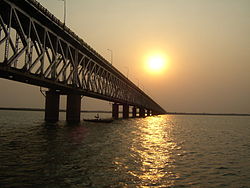This article needs additional citations for verification. (April 2008) |
Godavari Bridge | |
|---|---|
 The Godavari Bridge across Godavari River | |
| Coordinates | 16°59′52″N 81°45′21″E / 16.99778°N 81.75583°E |
| Carries | Two lanes of Road and Single Railway line. |
| Crosses | Godavari River |
| Locale | Rajahmundry |
| Other name(s) | Rajahmundry–Kovvur Bridge |
| Preceded by | The Havelock Bridge |
| Followed by | Godavari Arch Bridge |
| Characteristics | |
| Design | Truss Bridge |
| Total length | 4.1 kilometres (2.5 mi) |
| Longest span | 91.5 metres (300 ft) |
| No. of spans | 27 |
| History | |
| Engineering design by | Braithwaite, Burn & Jessop Construction Company |
| Opened | 16 August 1974 |
| Location | |
 | |
The Godavari Bridge or Kovvur–Rajahmundry Bridge is a truss bridge spanning the Godavari River in Rajahmundry, India. It is India's fourth longest road-cum-rail bridge crossing a water body, the first one being the Bogibeel Bridge over the Brahmaputra in Assam,[1] and second is Digha–Sonpur Bridge over the Ganga in Bihar.
The Godavari bridge is 4.1 kilometers (2.8 km Rail part & 4.1 km Road part) long consisting of 27 spans of 91.5 m and 7 spans of 45.72 m of which 6 spans of 45.72m are in 6 deg. curve at long Rajahmundry end to make up for the built up area. The bridge has a road deck over the single track rail deck, similar to the Grafton Bridge in New South Wales, Australia. This bridge, in addition to Godavari Arch Bridge, has been widely used to represent Rajahmundry in arts, media, and culture. It is one of the recognised symbols of Rajahmundry.[2]